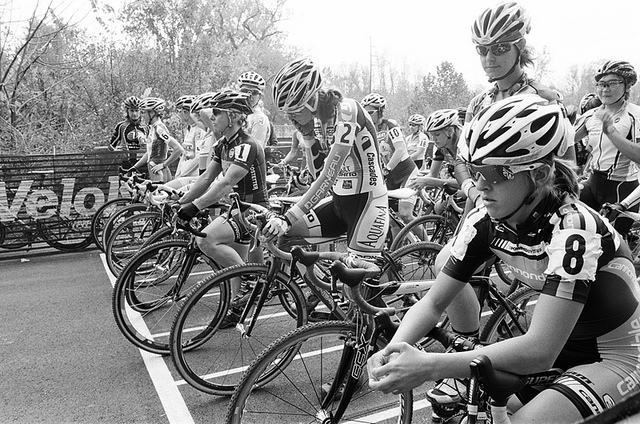
Brian at the Tour d’ Afrique, the subject of his film Where Are You Go? Photo from Good Problem.
Brian Vernor has a cool thing going for himself. The fourth-generation Santa Cruz, CA resident is a photographer, filmmaker, and adventurer who travels the world using his cameras to tell stories (and very frequently, ones about bikes). Sometimes it’s companies like Rapha or Jamis who send him off on a job. Other times its for his own projects like The Cyclocross Meeting and Where Are You Go, films that he shot in Japan and across Africa respectively. I spoke to Brian about his start as a filmmaker and photographer, his love for cyclocross, his adventure on a “rail bike,” the subjects currently catching his eye, and more.
When did you start getting into bikes? Has it been a lifelong infatuation or did the love come later on in life?
If you didn’t love riding a bike as a kid I don’t know what to say. For almost everyone bikes were the first chance to do something your parents had no control over.
have formal training/education or is it self-taught?
I took some film classes in college, but mostly it’s been self-taught. I wasn’t in a rush to make a life of photographing and making films. It’s evolved slowly. I never interned, or received professional training, so I guess I have more affinity with artists who use photography as a means, and less affinity with pure photographers who love the gear and the act of making pictures maybe regardless of a sympathy for the subject. I mean, I need something to say to motivate the picture. I certainly work for other people, but when Cannondale or Giro or Rapha ask me to do photos and videos they aren’t really asking for a style that isn’t me.

Brian on the job. Photo courtesy of Brian.
They intersected first with Pure Sweet Hell, but since then they haven’t really departed from each other. Of course I do a lot more than bike filming but as far as publishing goes it’s mostly the bike stuff gets out there.
as a filmmaker. This shines through in Pure Sweet Hell with much of it
strongly resembling early 16mm surf films. What is it about surf films that
draw you in and what have you tried to emulate from them in your own work?
I guess at this point it’s more accurate to say that California has had a huge influence on me. I think surf films come from that, too. Like this place almost imposes an aesthetic, one that is in awe of the natural world. With that in mind, I’m interested in creating sense of place as much as showing an action.
Given that you made Pure Sweet Hell (arguably the authoritative cyclocross documentary) and The Cyclocross Meeting, it seems safe to assume you like cross. What draws you to the sport as both a filmmaker and a participant?
As a filmmaker I like how individual rider style shows up in cross. Not much of cycling translates to non-cyclists, but with cross, with the combination of weather, course, the dismounting/mounting, and the all-out effort it seems to break down the mystery. Just about anyone can see it for the first time and know it is ridiculously hard and the best riders stand out for how they carry themselves on the bike and how they negotiate the course. I like that it’s documentary, but because of the repetition there’s a chance to set up shots.
Personally, I like leaning over on skinny tires, on dirt. I like that when you fail there’s probably someone there to see it. You’re on display. I like that if you live in a city you might be able to ride your bike to the race. I like that there are evolving insider jokes—like taking a beer hand-up used to mean you weren’t too serious but then the beer hand-down became a more clear statement of that. I like that there is still variation in how it’s done from place to place. If anything it bothers me the more codified the racing and the race culture becomes. It’s better that a Santa Cruz course is different than a Boston course and it’s way better that our party is different than yours. With some effort we might be able to keep it from becoming the homogeneous, sterile thing that road racing became.

One of the rail bikes. Photo courtesy of Brian.
Rick Hunter is a custom bike builder here in Santa Cruz. He’s a huge influence on me. He’s kind of one of those people who doesn’t speak until it’s important. Anyway, he’s a friend and it’s not like we can’t just shoot the shit and drink a few beers but I really like how he thinks about bikes. He’d had a glimmer in his eye for ten years anytime he brought up rail bikes. They are bikes designed to ride on conventional rail lines. He didn’t invent them, but he really wanted to make a bike that could ride the rails AND ride singletrack. So he figured out a simple and lightweight way to make the bike convertible for both scenarios and then we went and pedaled around Northern California for a week. The trip didn’t work out as easy as we’d hoped. Lot’s of portaging. The inconsistencies in rail lines make it hard to trust the outrigger set-up we had. Some crashing. It’s actually really scary being on the rails. The extra six inches off the ground looks like more when you’re perched up there on a 2 1/2 inch rail.
The project was really an experiment. We did the trip with two other friends and when we got Bike Magazine into it we wanted the whole thing to be as much about some buddies out for an adventure and not only about the spectacle of the rail bikes.

The pro women field at a cross race, as shot by Brian. Photo courtesy of Brian.
This isn’t a single or specific project, but I’m looking real hard at women’s racing. It’s amazing to see what level the teams are at right now. The Giro Donne is for real. The Classics courses are real. The athletes are professional.
It’s interesting to look at how poorly cycling journalism has been with women, and how poorly sports marketing attempts have been with women’s sports in general. It’s not easy to get it right when the publishers and brands feel like they have to treat it differently. I think it’s easy to get it right when it’s treated exactly the same, but that’s not ideal either, not every time.

Pingback: Brian Vernor Interview | Culture Cycles